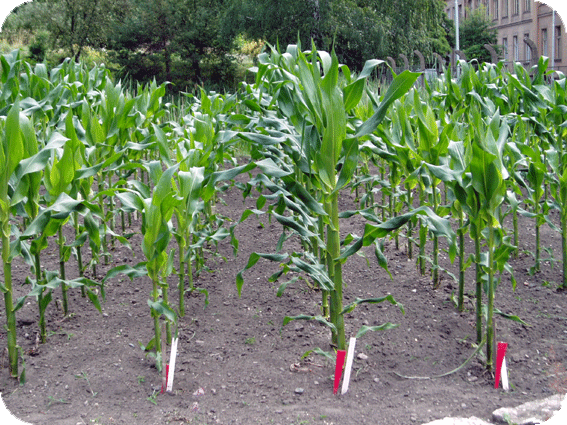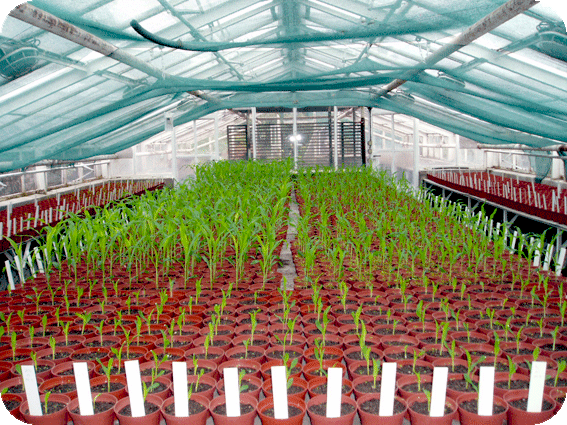Laboratory of Plant Genetics
Head:
doc. RNDr. Dana Holá, Ph.D.
Department of Genetics and Microbiology
Study consultant and guarantor of Ph.D. study programme Molecular and Cellular Biology, Genetics and Virology, Webmaster, HRIS administrator
Albertov 8, 2NP, room 204
Where to Find Us:
Brožek´s Genetic Garden, Studničkova N12/Albertov 8, Prague 2 - New Town, 128 43
Team MembersMethodology and Technical SupportScientific CollaborationsPublications |
TeachingProposed Topics of Theses for New StudentsStudent Theses in ProgressPast Student Theses |
Research Interests
 The Laboratory of Plant Genetics has long been engaged in the study of intraspecific variability in various biochemical, physiological, morphological, growth, reproductive and yield characteristics of various crop plant species. Special attention has been given to the manifestation and possible causes of the so-called heterosis effect (hybrid vigor) in different generations of hybrids. Currently, the Laboratory's research focuses primarily on studying the different resistance of various plant genotypes to adverse environmental conditions, from the whole organism down to the cellular and subcellular levels.
The Laboratory of Plant Genetics has long been engaged in the study of intraspecific variability in various biochemical, physiological, morphological, growth, reproductive and yield characteristics of various crop plant species. Special attention has been given to the manifestation and possible causes of the so-called heterosis effect (hybrid vigor) in different generations of hybrids. Currently, the Laboratory's research focuses primarily on studying the different resistance of various plant genotypes to adverse environmental conditions, from the whole organism down to the cellular and subcellular levels.
Throughout their lives, plants are often exposed to unfavorable environmental conditions - stressors. These stressors trigger a complex cascade of changes within the plant body; some of these changes are unique to a specific type of stress factor, while others are common to multiple stressors. A common denominator of many stress responses includes a reduction in photosynthetic efficiency, increased production of reactive oxygen species associated with cellular damage, and an increase in the synthesis or activity of various protective proteins and metabolites. The parameters associated with these processes can be with advantage used as biomarkers in the selection and breeding of genotypes resistant to various stressors. In the Laboratory of Plant Genetics, these parameters have been studied in the past in connection with low-temperature stress; currently, the research focuses on plant responses to drought or hypoxia associated with flooding. The research involves economically significant plant species, often comparing not only sensitive and resistant genotypes but also analyzing their hybrids to determine whether good resistance to a specific stressor is inherited from generation to generation and what mechanisms are involved.
 However, plant responses to adverse environmental conditions are by no means a simple process. The ultimate outcome of any stress factor's impact depends on its intensity, duration, the developmental stage of the plant, and interactions between stressors, which can significantly influence the nature of the stress response compared to the effect of each stressor separately, potentially amplifying or mitigating damage to the plant organism. Plants can also "remember" previous exposure to a stressor through various molecular-biological and biochemical mechanisms, enabling them to be better prepared for the next round of stressor exposure. The Laboratory is currently intensively studying the possible biochemical basis of "stress memory" in plants in cases of repeated or combined water stress. In this context, differences between various genotypes, including differences between parents and their hybrids, are also being examined.
However, plant responses to adverse environmental conditions are by no means a simple process. The ultimate outcome of any stress factor's impact depends on its intensity, duration, the developmental stage of the plant, and interactions between stressors, which can significantly influence the nature of the stress response compared to the effect of each stressor separately, potentially amplifying or mitigating damage to the plant organism. Plants can also "remember" previous exposure to a stressor through various molecular-biological and biochemical mechanisms, enabling them to be better prepared for the next round of stressor exposure. The Laboratory is currently intensively studying the possible biochemical basis of "stress memory" in plants in cases of repeated or combined water stress. In this context, differences between various genotypes, including differences between parents and their hybrids, are also being examined.
 The second main research topic of the Laboratory currently concerns the role of various steroid compounds, primarily brassinosteroids and ecdysteroids, in the plant organism. Brassinosteroids are phytohormones and play a crucial role in a number of processes occurring in plants; however, the precise changes that brassinosteroids induce in plant cells/tissues are still not fully understood. We are studying the effects of brassinosteroids on various components of the photosynthetic apparatus, but are particularly interested in the differences in response of different plant genotypes to the exogenous application of these substances. We also explore the relationship between brassinosteroids and the plant stress response, because brassinosteroids, among other things, protect plants against a range of biotic and abiotic stressors. This protective function of brassinosteroids, along with the fact that they are harmless to both the environment and the consumer, and have a high biological activity at extremely low concentrations, makes them ideal candidates for inclusion in modern cultivation technologies and methods aimed at enhancing plant resistance to unfavorable environmental conditions.
The second main research topic of the Laboratory currently concerns the role of various steroid compounds, primarily brassinosteroids and ecdysteroids, in the plant organism. Brassinosteroids are phytohormones and play a crucial role in a number of processes occurring in plants; however, the precise changes that brassinosteroids induce in plant cells/tissues are still not fully understood. We are studying the effects of brassinosteroids on various components of the photosynthetic apparatus, but are particularly interested in the differences in response of different plant genotypes to the exogenous application of these substances. We also explore the relationship between brassinosteroids and the plant stress response, because brassinosteroids, among other things, protect plants against a range of biotic and abiotic stressors. This protective function of brassinosteroids, along with the fact that they are harmless to both the environment and the consumer, and have a high biological activity at extremely low concentrations, makes them ideal candidates for inclusion in modern cultivation technologies and methods aimed at enhancing plant resistance to unfavorable environmental conditions.
In the case of plant analogs of insect hormones, ecdysteroids, their function in plants is still mostly unknown; they are primarily thought to play a role in plant protection against insects and other similar biotic stressors. The Laboratory of Plant Genetics was the first to demonstrate that these compounds can also affect the photosynthetic apparatus in vivo; however, it appears that there are differences among plant species in this regard, and that ecdysteroids may functionally interact with brassinosteroids.
In addition to crop plants, members of the Laboratory have also studied deciduous and coniferous forest trees. As part of this research, we developed a method for isolating photochemically active chloroplasts from needles, which is applicable to various coniferous tree species and enables the measurement of the activity of different parts of the photosynthetic electron transport chain. This research was conducted in collaboration with the Laboratory of Ecophysiological Anatomy at the Department of Experimental Plant Biology of the Faculty of Science, Charles University, and the Department of Forest Genetics and Physiology of the Faculty of Forestry and Wood Sciences, Czech University of Life Sciences in Prague. The research focused on the potential use of non-destructive photosynthetic parameters as suitable markers in forest tree breeding.





















